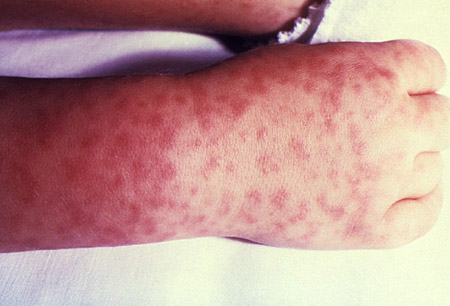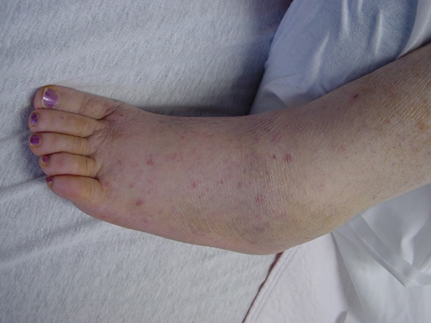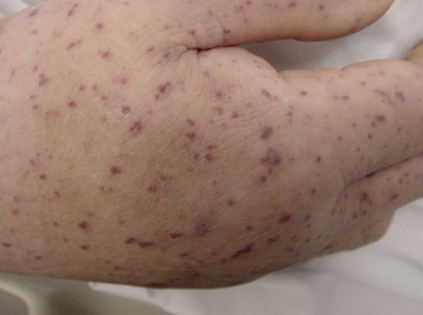History and exam
Key diagnostic factors
common
triad of fever, rash, and history of tick exposure
Present in 45% to 67% of patients.[12]
triad of fever, rash, and headache
Present in 44% to 58% of patients.[12]
fever
rash
Approximately 90% of patients will eventually get a rash. It typically occurs 2-4 days after the onset of fever.[16]
Present in >95% of children and 80% of adults. Only present in <50% of adults in the first 3 days of illness, but can appear after 1 to 2 days of illness in children. Usually maculopapular at first, but can begin with petechiae.[12][13][16]
A petechial rash develops in 50% to 60% of patients, usually after 1 to 2 days of maculopapular rash.[12][13]
The presence of a maculopapular or petechial rash markedly increases the likelihood of Rocky Mountain spotted fever; however, the absence of a rash does not exclude the diagnosis.[Figure caption and citation for the preceding image starts]: Child's right hand and wrist displaying the characteristic spotted rash of Rocky Mountain spotted feverCDC Image Library; used with permission [Citation ends]. [Figure caption and citation for the preceding image starts]: Macular rash of early Rocky Mountain spotted feverFrom the collection of Dr Christopher A. Ohl; used with permission [Citation ends].
[Figure caption and citation for the preceding image starts]: Macular rash of early Rocky Mountain spotted feverFrom the collection of Dr Christopher A. Ohl; used with permission [Citation ends]. [Figure caption and citation for the preceding image starts]: Maculopapular and petechial rash of Rocky Mountain spotted feverFrom the collection of Dr Christopher A. Ohl; used with permission [Citation ends].
[Figure caption and citation for the preceding image starts]: Maculopapular and petechial rash of Rocky Mountain spotted feverFrom the collection of Dr Christopher A. Ohl; used with permission [Citation ends].
myalgia
Myalgia and malaise are usually present.[16]
uncommon
Other diagnostic factors
uncommon
Risk factors
strong
illness onset in spring or summer
returned travelers from an endemic area
residence in or recent exposure to rural area
recent (within 2 weeks) outdoor exposure
A detailed history of recent recreational or occupational outdoor activities may reveal potential tick exposures that were unknown to the patient.
In endemic areas, such as northern Mexico or southwestern US, patients may be exposed to ticks in their own yards. A recent camping or fishing trip suggests tick exposure, but most patients lack such historic clues.[12]
weak
known antecedent tick bite
exposure to dogs or pets that spend time outdoors
Dogs and pets that spend time outdoors are at risk of tick bites and getting infected.
Use of this content is subject to our disclaimer